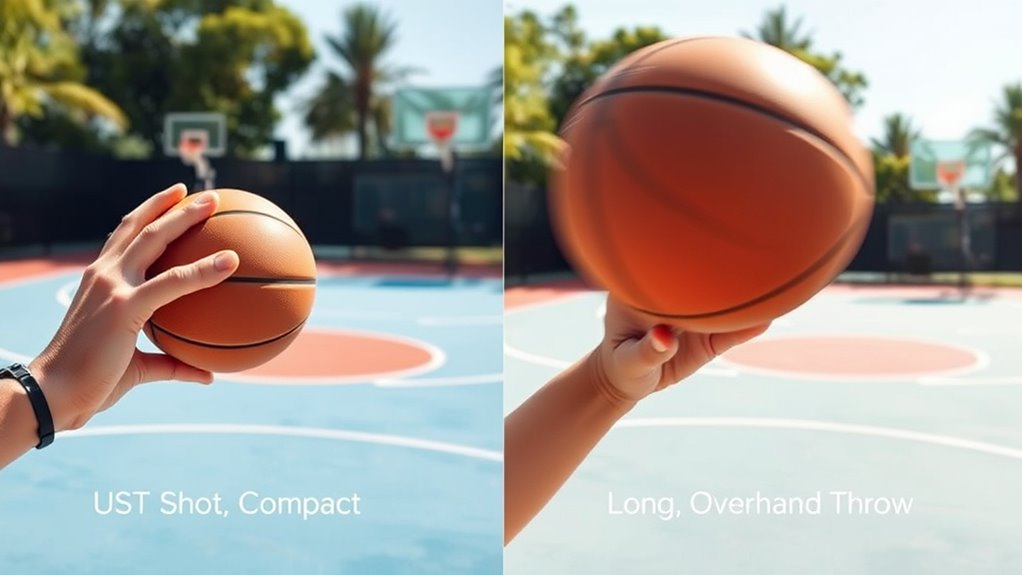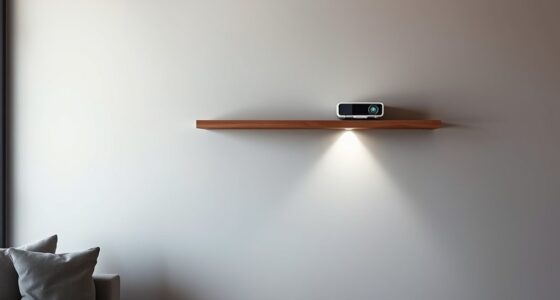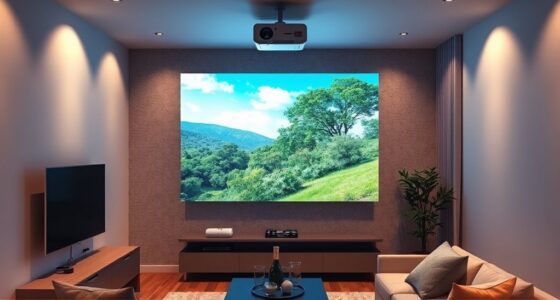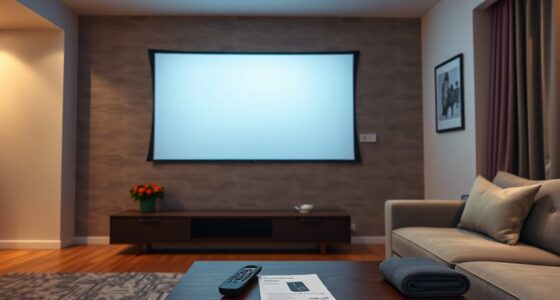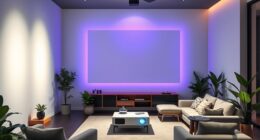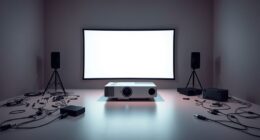Understanding UST versus long throw projectors helps you choose the right one for your space. UST models sit very close to the screen, perfect for small rooms and tight spaces, while long throw projectors need more distance, suited for larger rooms. Myths about installation and suitability often cause confusion. Focusing on room size, image quality, and flexibility is what really matters. Keep exploring, and you’ll discover exactly what fits your needs best.
Key Takeaways
- UST projectors are placed very close to the screen, ideal for small spaces, while long throw models require more distance for large images.
- Myths suggest UST is only for small rooms; in reality, both types can be used in various environments with proper setup.
- Projection angle, brightness, contrast, and color accuracy are more critical than throw distance alone for image quality.
- UST projectors offer easier installation and versatile mounting options, whereas long throw models need more space and calibration.
- Choosing the right projector depends on room size, ambient lighting, and specific visual needs, not just the throw type.
Understanding the Basic Differences Between UST and Long Throw Projectors
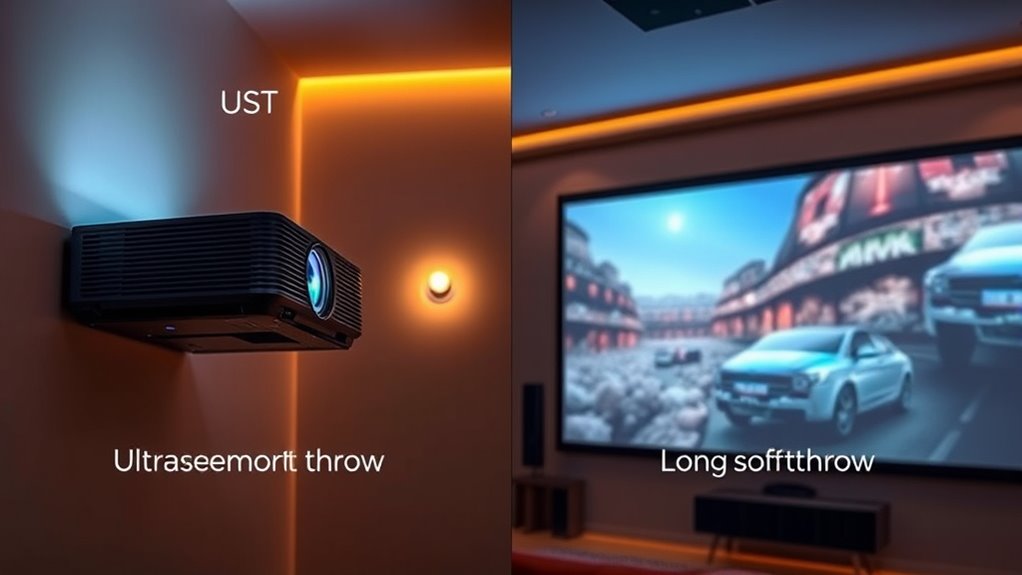
Understanding the basic differences between UST and long throw projectors is essential when choosing the right display solution for your space. UST projectors use ultra-short throw projection technology, allowing you to place them very close to the screen or wall, which minimizes shadows and clutter. Long throw projectors, by contrast, require more distance to project a large image, making them suitable for larger rooms. When comparing these types, pay attention to image resolution; both can offer high-definition clarity, but UST models often excel in maintaining sharpness at short distances. Your choice depends on your space constraints and desired image quality. Recognizing these fundamental differences helps you select the projector that best fits your environment and visual needs.
Common Misconceptions About UST and Long Throw Projectors
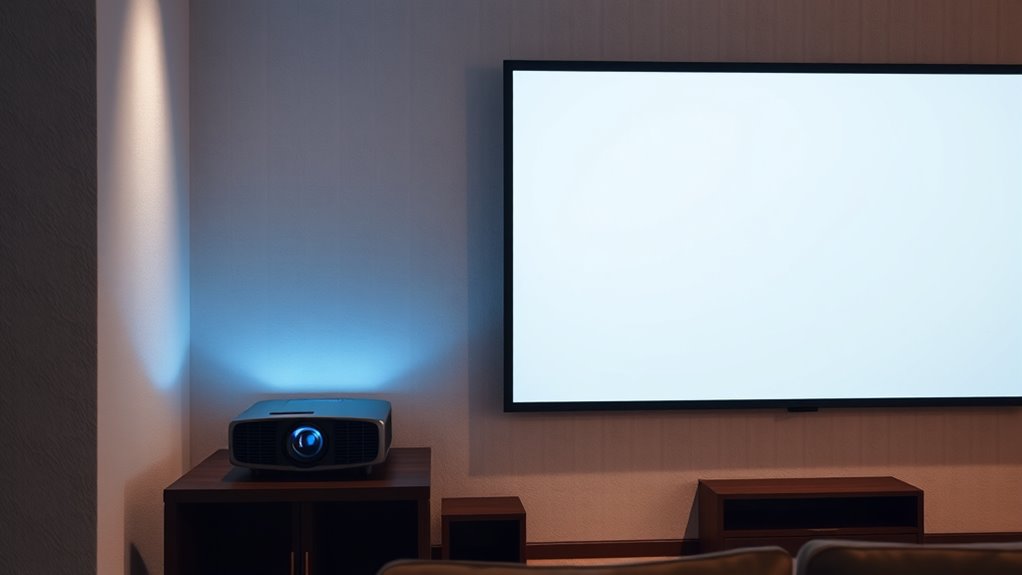
Many people assume that UST and long throw projectors are interchangeable or that one is always better than the other. This isn’t true. For example, some believe a ceiling mount makes any projector suitable for any space, but UST projectors require specific mounting options due to their ultra-short throw distance. Others think a remote control can fix placement issues, but effective positioning depends on the projector type. A common misconception is that UST projectors are only for small rooms, yet they work well in large spaces if properly installed. Conversely, long throw projectors aren’t necessarily better for larger rooms. Understanding these differences helps you avoid mismatched expectations and ensures you choose the right projector for your setup. Proper installation and understanding of projector types can significantly impact performance and image quality.
Key Factors to Consider When Choosing a Projector Type
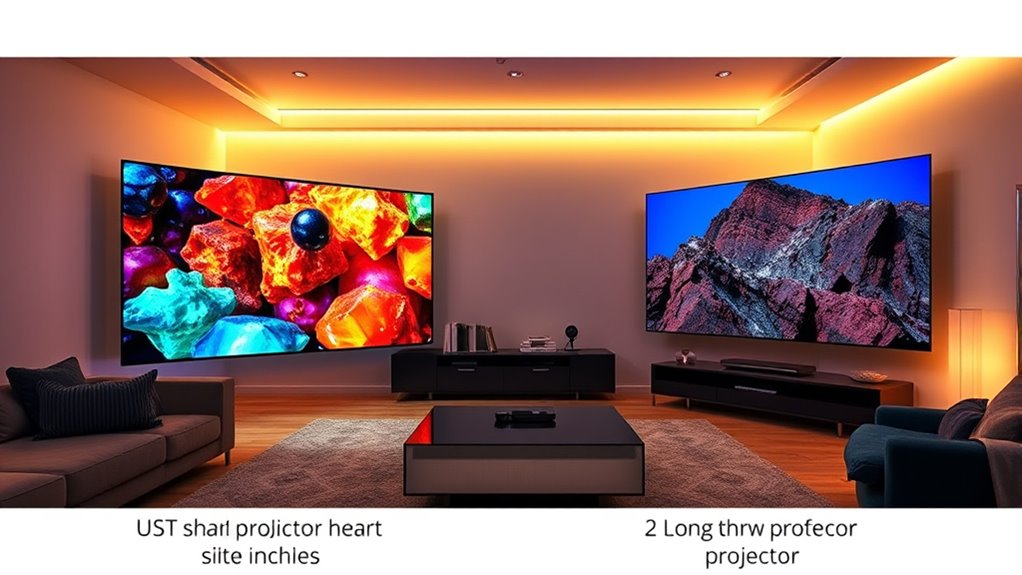
When choosing a projector, you need to think about your room size and how much space you have. Brightness and lumens are also essential to guarantee clear images in your lighting conditions. Additionally, consider how portable the projector is and how easy it is to set up for your specific needs. Being aware of the conflict resolution skills involved in setting up and maintaining your projector setup can help ensure a smooth experience.
Room Size Compatibility
Choosing the right projector depends heavily on your room size, as it determines how far the projector needs to be placed from the screen and how large the image will be. For small rooms, a short throw or ultra-short throw (UST) projector is ideal because it can be mounted close to the wall or ceiling without sacrificing image size. In larger spaces, long throw projectors work better, requiring more distance but offering bigger images. Consider these key points:
- Ceiling mounting options for space-saving setup
- Wall compatibility for seamless integration into your room’s design
- Room dimensions to ensure the projector’s throw distance matches your available space
- Proper placement is crucial to maximize picture quality and minimize shadows, especially in a farmhouse bedroom setting.
Matching your room size with the projector’s capabilities guarantees maximum performance and a clutter-free setup.
Brightness and Lumens
Brightness and lumens determine how well your projector performs in various lighting conditions. If you’re in a bright room, you’ll want a projector with higher lumens to guarantee clear, vibrant images. The projection technology plays a key role here; some techs deliver better brightness efficiency, making them suitable for well-lit spaces. Additionally, color accuracy is essential—higher brightness doesn’t mean much if the colors look washed out. Look for a projector with sufficient lumens that also maintains true-to-life colors, especially if you’re watching movies or presentations where visuals matter. Keep in mind that UST projectors often have lower lumens but excel in brightness in close proximity, while long throw models typically offer higher lumens for larger, well-lit environments. Choosing the right brightness level is also influenced by contrast ratio, which affects the depth and clarity of images in different lighting conditions.
Portability and Setup
Portability and setup are crucial factors that can make or break your projector experience, especially if you plan to move it frequently or use it in different locations. A portable projector allows you to easily carry it and set it up quickly, saving time and effort. When considering setup, think about:
- Screen size flexibility – choose a projector that can easily adapt to different screen sizes without complicated adjustments.
- Throw distance – ensure it fits your space; short-throw projectors require less room, making setup easier in tight spots.
- Weight and size – lighter, compact models are more portable and convenient for on-the-go use or frequent relocation.
- Environmental impact — selecting energy-efficient projectors can reduce power consumption and minimize your ecological footprint.
Prioritizing these factors helps you enjoy a seamless, adaptable setup wherever you choose to project.
Space and Room Size: How They Influence Your Choice
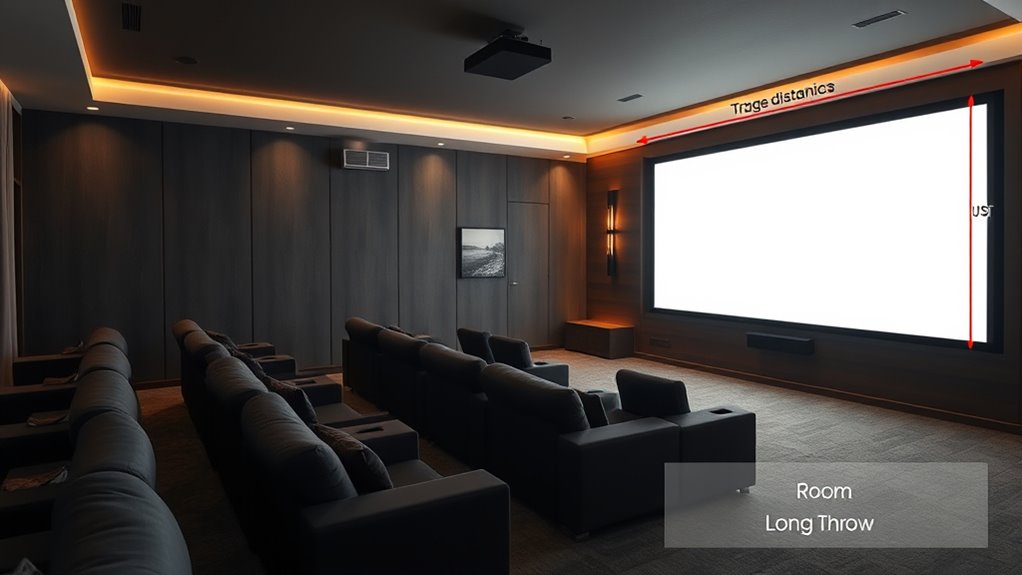
Your room size and layout directly affect which projector works best for you. A small space may limit your options, making short-throw or ultra-short-throw projectors ideal. Larger rooms give you more flexibility, allowing for long-throw projectors that require more distance. Additionally, considering the water park attractions in your area can help you plan entertainment options that complement your viewing setup.
Room Dimensions Matter
The size of your room considerably influences whether an ultra short throw (UST) or long throw projector is the better choice. Smaller rooms favor UST projectors because they require minimal space for ceiling mounting or wall placement, making setup easier. Larger rooms, however, often need long throw projectors to cover the distance comfortably. Consider these points:
- For limited space, choose a UST projector that can be placed close to the screen or wall.
- When room dimensions are spacious, a long throw projector offers more flexibility for wall placement.
- Ceiling mounting height matters; UST projectors are ideal for low ceilings, while long throw models work better in taller spaces.
- Understanding asset division laws can help in planning your setup if you’re sharing the space or moving to a new home with different room configurations.
Your room’s dimensions directly impact the projector’s placement options and overall performance.
Projector Throw Range
Choosing the right projector throw range depends heavily on your space and room size. The projection angle and throw ratio are key factors in making this choice. A short throw projector has a low throw ratio, allowing it to project a large image from a short distance, ideal for smaller rooms. Conversely, long throw projectors require more space but can produce bigger images at greater distances. Consider your room’s dimensions to determine the *best* projection angle—steeper angles can cause distortion, while a proper throw ratio ensures image clarity and size. If your room is limited in space, a UST (Ultra Short Throw) projector might be *most suitable*, as it can be placed close to the screen. For larger rooms, a standard or long throw projector offers more flexibility in placement and size. Additionally, understanding Mazda Tuning features can help optimize your setup by customizing your environment for better projection performance.
Space Constraints Impact
Room size and available space directly influence which projector throw type works best for you. If your room is small, a short or ultra-short throw projector is ideal, as it requires less distance from the wall or ceiling mount. Larger rooms give you more flexibility to choose long throw projectors, which need more space to project a clear image. Consider these points:
- Ceiling mount placement: In tight spaces, a ceiling mount for an ultra-short throw projector keeps it out of the way.
- Wall placement: Walls close to the viewing area may limit long throw options, making wall-mounted short throw projectors more suitable.
- Room dimensions: Smaller rooms need projectors that can project large images from a close distance without cluttering the space.
- Image quality considerations: Proper projector placement based on room size ensures optimal image clarity and setup convenience.
Image Quality and Brightness: Do They Differ Significantly?
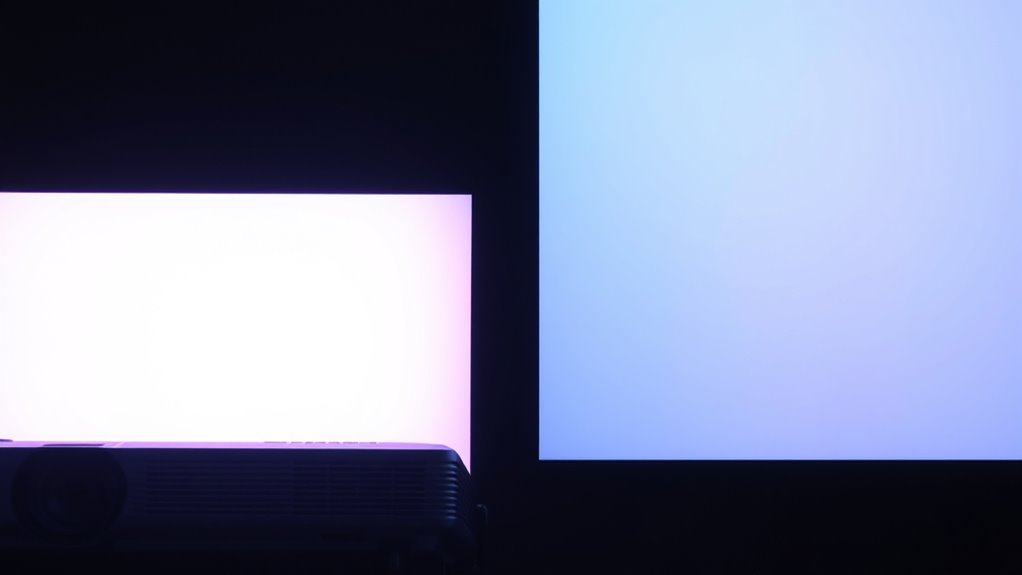
Although both UST (Ultra Short Throw) and long throw projectors aim to deliver clear images, their image quality and brightness levels can differ noticeably. UST projectors often produce brighter images with higher contrast levels, making them ideal for well-lit rooms. Long throw models may struggle with maintaining consistent image clarity in bright environments but excel in contrast when ambient light is controlled. Here’s a comparison:
| Feature | UST Projectors | Long Throw Projectors | Notes |
|---|---|---|---|
| Brightness | Generally higher | Slightly lower | Affects visibility in ambient light |
| Image Clarity | Sharp, detailed | Slightly less sharp | Depends on lens quality and resolution |
| Contrast Levels | Better contrast | Moderate contrast | Essential for vibrant, vivid images |
Additionally, lens quality plays a crucial role in determining overall image sharpness and clarity for both types of projectors.
Installation and Setup: Ease of Use for UST and Long Throw Models
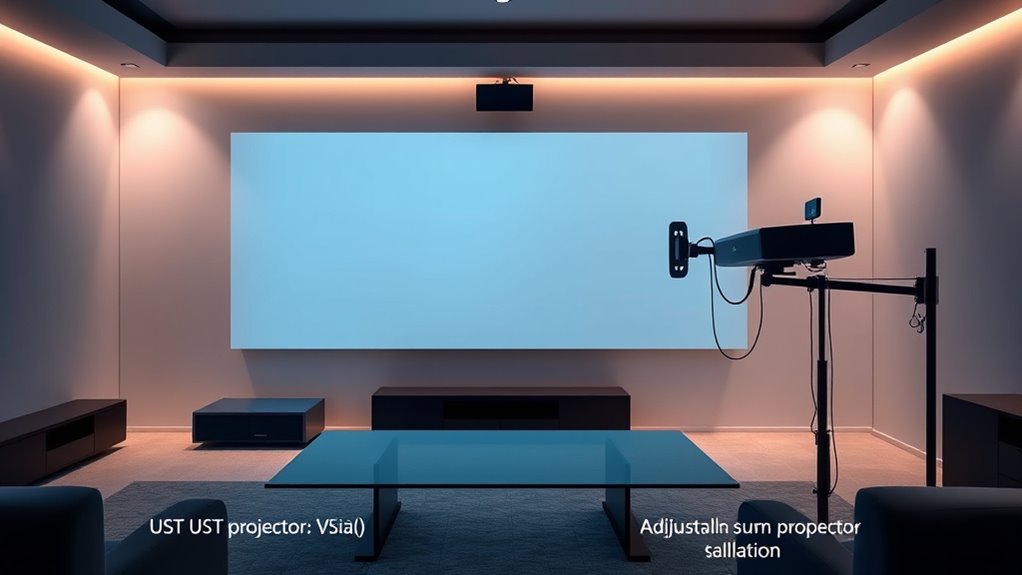
Setting up your projector can feel straightforward or challenging depending on the model. UST projectors usually require less space and simpler calibration, while long throw models might need more room and detailed adjustments. Let’s compare how easy each type is to install and get working smoothly.
Setup Complexity
Installing and setting up a UST projector is generally straightforward, thanks to its compact design and simple mounting options. Its projection technology allows for quick alignment, reducing setup time. The user interface on most models is intuitive, making adjustments easy. Consider these key points:
- Minimal calibration: UST projectors often require less fine-tuning due to their fixed lens systems.
- Plug-and-play setup: Most models connect directly to your device, simplifying initial setup.
- Auto keystone correction: Many UST projectors feature automatic adjustments, reducing manual effort.
Compared to long throw models, UST projectors emphasize simplicity in setup, making them ideal for quick installation and easy use, especially if you’re less tech-savvy.
Space Requirements
UST projectors are designed to fit into smaller spaces, making them ideal for rooms with limited room for equipment. You can achieve a larger screen size without needing a long throw distance, which helps conserve space. Since UST models sit close to the wall or screen, they require less room behind them and make setup easier. When choosing a projector, consider the aspect ratio to ensure the image fits your desired screen size perfectly. Long throw projectors need more space to project a large image, which can be challenging in smaller rooms. With UST models, setup is straightforward because you won’t need to reposition furniture or rearrange your space to accommodate the projector’s distance. Overall, UST projectors offer a more flexible and space-efficient solution for your setup needs.
Calibration Process
While both UST and long throw projectors require calibration for ideal image quality, UST models generally offer a simpler setup process. With UST projectors, you typically just position the unit, power it on, and follow on-screen prompts for projection calibration. Long throw models often need more steps to achieve perfect image alignment, involving adjusting throw distance and keystone correction.
Here’s what to expect:
- Easy-to-follow instructions for projection calibration ensure your image is sharp and properly aligned.
- UST projectors usually have automatic image alignment features, simplifying setup.
- Long throw units may require manual adjustments for image alignment, making calibration more time-consuming.
Cost and Budget Considerations for Different Projector Types
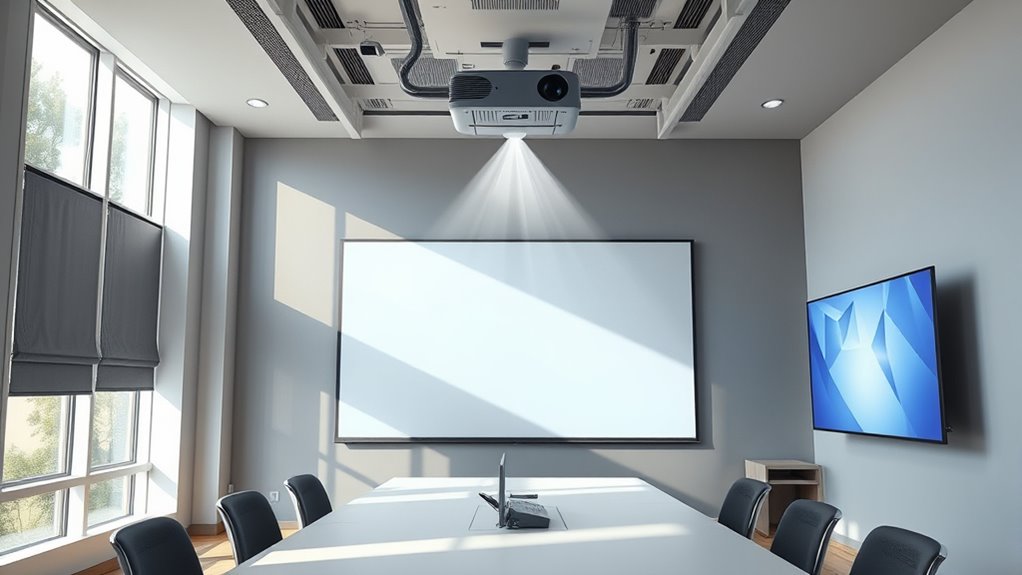
Choosing the right projector often depends on your budget, as different types come with varying costs. Conducting a thorough cost analysis helps you understand initial purchase prices, maintenance, and replacement expenses, making your budget planning more accurate. UST projectors generally cost more upfront due to their advanced technology and compact design, but they can save money by reducing installation needs. Long throw projectors tend to be more affordable initially but may incur higher installation costs if they require extensive mounting or room modifications. When comparing options, consider not only purchase price but also ongoing expenses like bulb replacements and repairs. Balancing these factors ensures you select a projector that fits your financial plan while meeting your performance expectations.
Flexibility and Placement Options: Which Offers More Convenience?

When it comes to flexibility and placement options, UST projectors often provide greater convenience due to their compact size and versatile mounting possibilities. Their small form factor allows you to install them in tight spaces or on various surfaces without hassle. Consider these advantages:
- Multiple mounting options enable easy installation on ceilings, walls, or furniture, adapting to your space.
- Wall compatibility is high, making it simple to place the projector directly against or near walls for a seamless look.
- Their size allows for quick repositioning if you want to change your setup or room layout.
Common Use Cases for UST Versus Long Throw Projectors
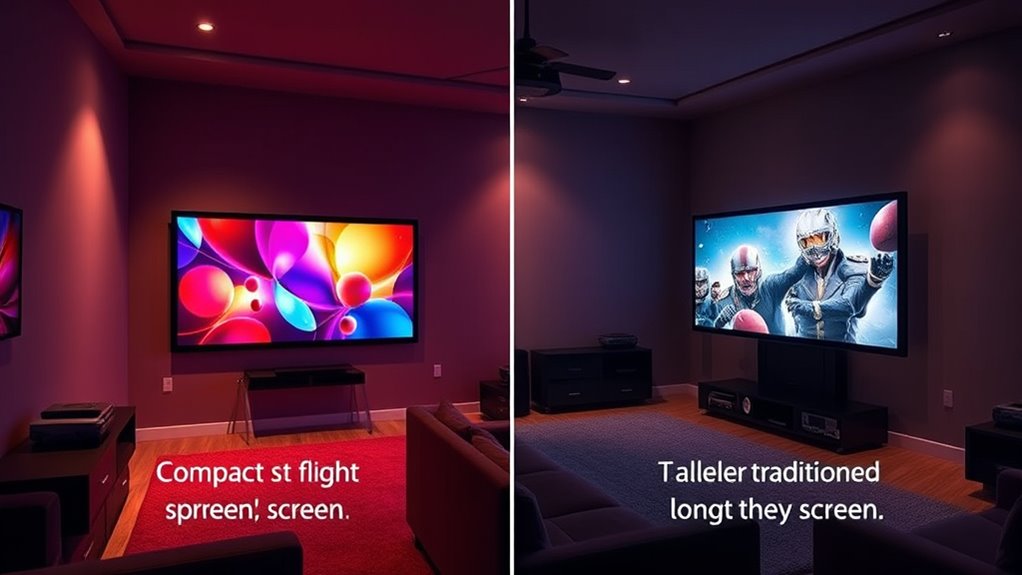
UST projectors are ideal for small to medium spaces where you want a large image without requiring a long throw distance. They’re perfect for home theaters, small conference rooms, or classroom settings, offering impressive screen size even in tight spaces. Because they project at a short distance, you can place them close to the screen, reducing clutter and obstructions. UST models often feature integrated audio, making setup simpler and eliminating the need for extra speakers. This makes them great for multimedia presentations, gaming, or streaming movies where a clean, minimal setup matters. Long throw projectors, in contrast, are better suited for larger venues or spaces where distance isn’t an issue. Choosing between the two depends on your room size, desired screen size, and whether integrated audio is a priority.
Debunking Myths: What Really Matters When Selecting a Projector
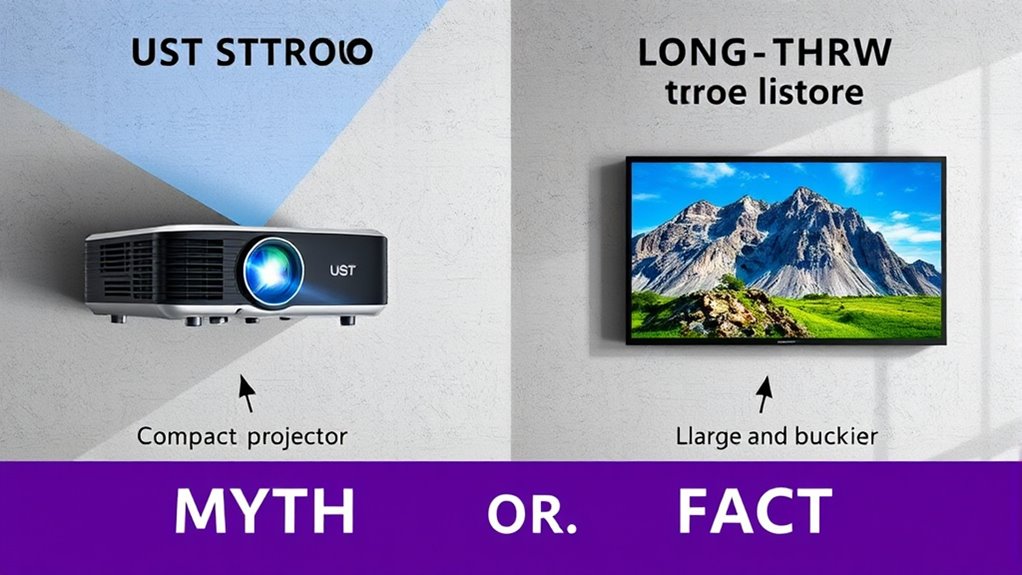
Many people assume that the most important factor in selecting a projector is its throw distance or resolution, but that’s a myth. What truly matters are aspects like projection angle, lamp life, and image quality.
- Projection angle: Ensuring the projector can adjust easily to fit your space is vital, especially for UST models with unique angles.
- Lamp life: Longer lamp life minimizes maintenance and replacement costs, making your projector more reliable over time.
- Image quality: Brightness and color accuracy often outweigh resolution alone, especially in well-lit environments.
Focusing on these factors helps you choose a projector that fits your needs, avoids common pitfalls, and delivers consistent performance.
Frequently Asked Questions
Can UST Projectors Be Used Outdoors Effectively?
Yes, UST projectors can be used outdoors effectively if they have good outdoor durability and weather resistance. You should look for models specifically designed for outdoor use, as they stand up better against moisture, dust, and temperature changes. Proper setup, like using a protective cover and placing the projector in a shaded area, will help guarantee clear images and longevity, making your outdoor movie nights enjoyable and hassle-free.
Do Long Throw Projectors Require Special Mounting Equipment?
Long throw projectors often require specific, sturdy mounting equipment to guarantee stability and ideal positioning. You’ll find the installation process somewhat complex, needing precise mounting requirements to achieve the best picture quality. Proper mounting prevents projection problems like keystone distortion. So, yes, they usually demand specialized mounting gear and careful installation, but with proper planning, you’ll guarantee a secure setup that delivers a clear, engaging display.
How Does Ambient Light Affect UST Versus Long Throw Projectors?
Ambient light considerably impacts both UST and long throw projectors, but UST projectors handle ambient lighting better due to their proximity to the screen. You should consider ambient lighting when planning projector placement, ensuring minimal interference for a clear image. Long throw projectors, placed farther from the screen, are more affected by ambient light, so controlling room lighting enhances your viewing experience. Proper placement and lighting control are key to ideal picture quality.
Are UST Projectors More Prone to Overheating?
Think of your projector as a busy chef in a kitchen. UST projectors, like this chef, work intensely and can get hotter, making them more prone to overheating if their cooling systems aren’t up to par. While they’re built for durability, their compact design demands efficient cooling. Proper ventilation and quality cooling systems are key to preventing overheating, ensuring your UST projector stays reliable and functions smoothly over time.
What Maintenance Differences Exist Between UST and Long Throw Models?
You’ll find that UST projectors often require more frequent lens cleaning due to their compact design, which can attract dust more easily. Long throw models typically have easier access for bulb replacements, making maintenance simpler. Regularly clean the lens to guarantee sharp images, and replace bulbs promptly when needed to prevent brightness loss. Overall, maintenance differences focus on lens cleaning frequency and bulb replacement accessibility between the two types.
Conclusion
Choosing between UST and long throw projectors is like selecting the right key for your space’s melody. Both have their tune, but what truly matters is how well they fit your room’s rhythm. By understanding their differences and myths, you’ll find the perfect harmony for your viewing experience. Remember, the right projector isn’t just a tool—it’s the baton that conducts your home entertainment symphony.
